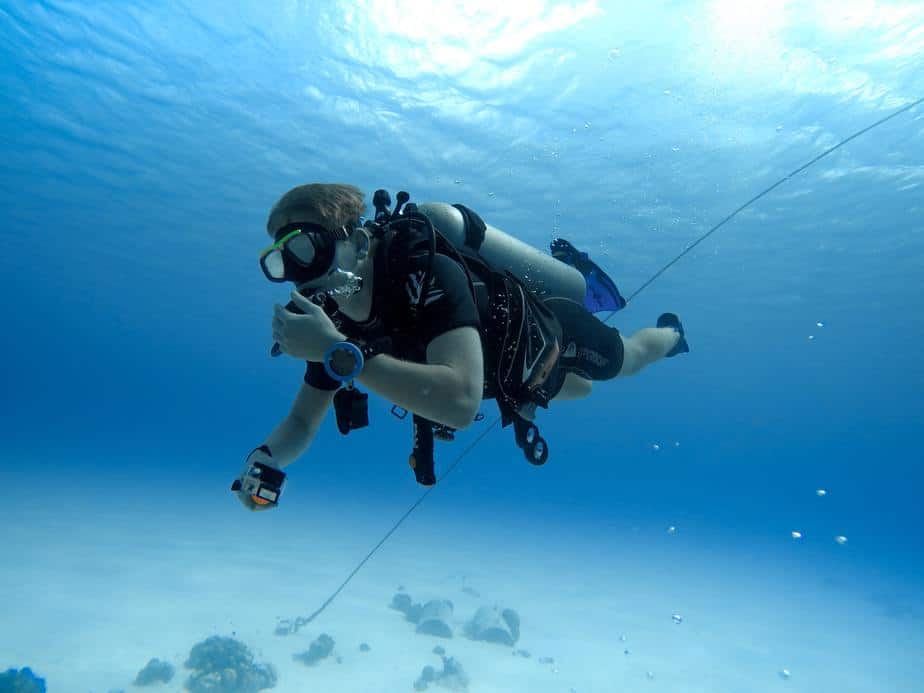When you’re a new scuba diver, you are excited to explore the vast underwater world that has now opened up to you. Each new location brings with it an entirely different experience, from the ecosystem, species of marine life, and wrecks to explore. To see it all, you’d have to stay underwater for a long time. And that’s where the problems come in.
At the end of the day, scuba divers are limited by how long they can stay underwater. There are many factors to consider, but the most likely culprit is that your scuba tank will eventually run out of air. After your tank reaches 500 psi (50 bar, or about 20% remaining), it’s time to start your ascent. Assuming you were diving recreationally at a depth of 12 m (40 ft) or less, it’d take about 45-60 minutes for your tank to run low. Some other factors to consider are dive depth, your no-decompression limit (NDL), breathing rate, physical fitness, tank size, and unexpected physical exertions that use up a lot of energy.
Your air source is how scuba diving is even possible. Understanding exactly how long you can use it for is essential for dive planning and for peace of mind underwater. As we mentioned, there are many factors to consider, and it is not possible to predict with exact certainty how long you can stay underwater. That’s why you need to check your pressure gauge often as if it’s the most natural thing in the world like breathing, because if you don’t, you’re going to find yourself unable to breathe really soon.
In this article, we’ll discuss the major factors that impact how long a scuba diver can stay underwater. Knowing these factors can help you extend your bottom times by ensuring that your scuba tank can last for as long as possible during a dive. Let’s get into it.
Factors that affect how long a scuba diver can stay underwater
Air consumption rate
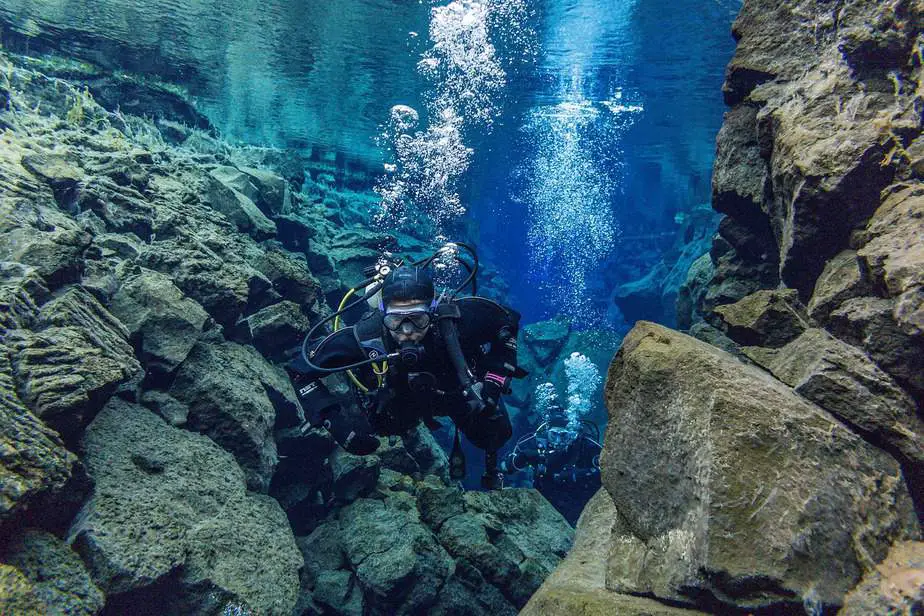
There is a correct way to breathe while scuba diving, as well as incorrect ways. Here’s how not to do it: if you take rapid and shallow breaths, you will reach the safety limit (500 psi/50 bar) much faster than someone breathing deeply and slowly.
If you take a group of divers who have the exact same stats: similar build, dive profile, fitness level, and all diving together in the same location, then the biggest difference between who surfaces first and who has the longest bottom time have to do with how well they control their breathing.
People underestimate how important regulating their breathing is to their bottom times. Slowing down and decreasing your heart rate is one of the fastest ways a beginner can improve their bottom times than any of the other options.
Your breathing rate is also affected by how physically fit you are. If you’re out of shape to the point that even minor physical exertions are causing you to gasp for air, then your scuba tank will be empty before anybody else’s. You need to be in relatively decent shape so that you can maintain a steady breathing rate, and this will only improve with practice.
Air consumption rate is also greatly affected by how deep you dive, which we’ll cover in its own section.
Tank capacity
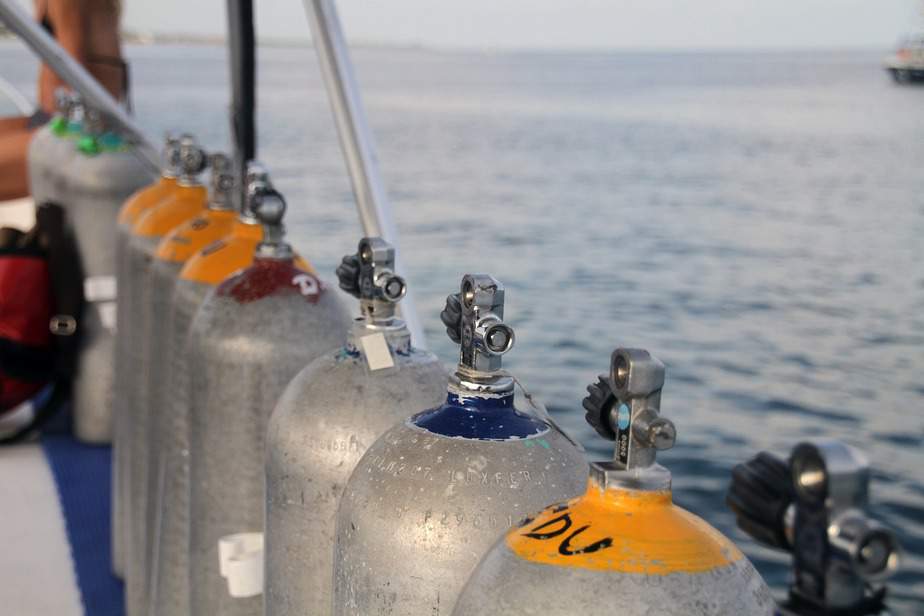
Another way you can improve your bottom times is by simply getting a tank with a larger capacity. Most rental scuba tanks that you’ll find at resort dive centers are 80 cu ft. aluminum tanks. The reason they are so popular is that they are cheaper than an equivalent sized steel tank, and you’ve probably already used one of them while getting your Open Water Diver certification.
Especially early on, how fast you deplete your scuba tank and ascend before others is probably the benchmark that you are using to compare your skill level to other divers. However, this is not a good point of comparison because there are many reasons why one might drain their tank faster than another.
For instance, if you’re a larger individual, particularly if you’re a male, you’re going to use up oxygen much faster than a petite woman for instance. There are larger tanks available for people who need more breathing gas.
Yet another factor which we’ll discuss in detail further below is that depth affects how quickly gas is used up as well. If a diver is going to do a particularly deep dive, and they want to have longer bottom times, this is one way to do so.
You’ll notice that technical divers are carrying at least two tanks with them in backmount or sidemount, and that’s because they need different breathing gases and some redundancy. The pressure at the depths that they dive at will cause their gas consumption rate to skyrocket as well, so they simply need more to breathe with.
Larger tanks are available for rental at dive shops for guests who simply need more air. However, as we’ll see in the next few sections, the benefit of having a larger tank may not be as great as you think depending on the other factors you encounter.
No-decompression limit (NDL)
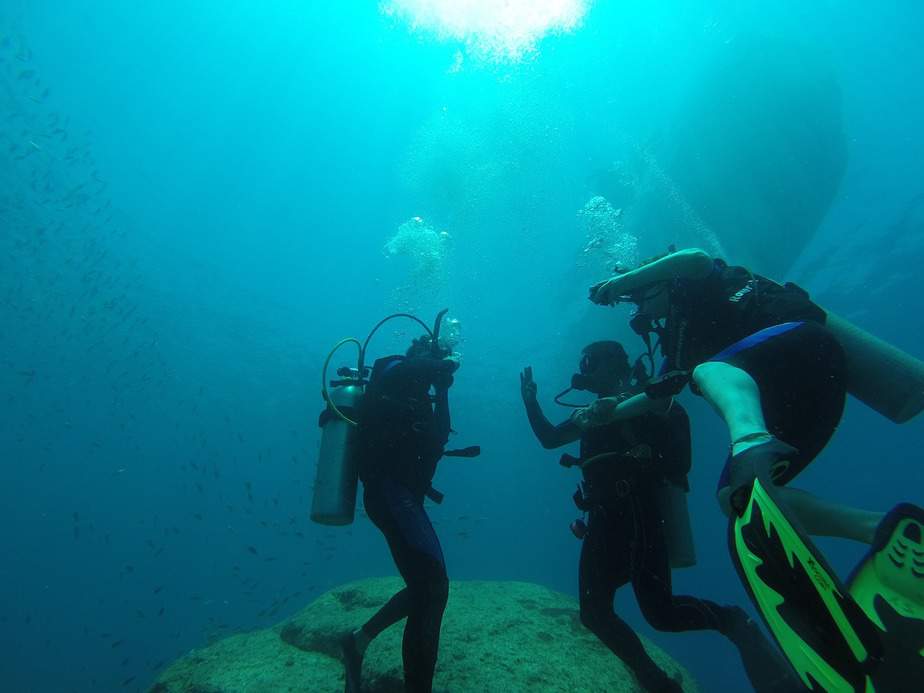
Most dives are no-decompression dives, which means that divers have to end their dive before they exceed their NDL. As you’ll remember, the NDL is the maximum amount of time you can spend underwater where you can safely ascend by staying under the ascent rate and only doing a single safety stop.
Exceeding the NDL requires you to perform decompression stops at various depths, and the depth you stop at and the amount of time you spend there depends on what you or your dive computer calculated. You should not be exceeding your NDL unless you are a technical diver, because this requires specific training to safely do.
Your NDL for each dive can vary because it depends on how deep you dive and how fast you breathe. The deeper you go, the shorter your NDL is. You’ll find that you cannot dive very deep for long if you still want to stay within your NDL. Check out this table below for some figures, all data is taken from the PADI Dive Table Planner.
| Depth | No-Decompression Limit |
| 35 ft (10.67 m) | 205 minutes |
| 40 ft (12.19 m) | 140 minutes |
| 50 ft (15.24 m) | 80 minutes |
| 60 ft (18.29 m) | 55 minutes |
| 70 ft (21.34 m) | 40 minutes |
| 80 ft (24.38 m) | 30 minutes |
| 90 ft (27.43 m) | 25 minutes |
| 100 ft (30.48 m) | 20 minutes |
| 110 ft (33.53 m) | 16 minutes |
| 120 ft (36.58 m) | 13 minutes |
| 130 ft (39.62 m) | 10 minutes |
| 140 ft (42.67 m) | 8 minutes |
As you can see, at shallow depths (say, less than 40 ft/12 m), your NDL is quite generous. You can stay underwater for over 2 hours without needing to perform any decompression stops. At these depths, your scuba tank will run out of air faster than you can reach your NDL.
Keep in mind that the figures provided by the table are estimates and can vary from person to person. Check your dive computer for the most accurate information. Furthermore, the NDLs provided assume that this is your first dive of the day. If you have dived multiple times already, your NDL will be shorter.
For recreational scuba divers, the NDL is basically their hard limit. Technically they can exceed it, and there is even a guideline called the PADI Emergency Deco Protocols that helps divers who accidentally exceed their NDL decompress. The guidelines are:
- If you exceed your NDL by up to 5 minutes, then make an 8 minute deco stop at 3 m (instead of the usual 3). After that, have a surface interval of at least 6 hours before you dive again on the same day.
- If you exceed your NDL by more than 5 minutes, then make a 15 minute stop at 3 m and do not dive for at least 24 hours.
Unless you have received the proper training to do decompression dives and have planned a decompression dive, do NOT exceed your NDL. Your risk of getting decompression sickness is increased if you don’t decompress properly, and this can have fatal consequences.
If you are a recreational scuba diver, the NDL should be strictly adhered to. This means that once you have almost reached your NDL, you should begin your ascent irrespective of how much air is remaining in your tank.
As we mentioned, at shallow depths the limiting factor is your air tank. At deeper depths, it’s possible that your NDL will be reached before your air tank is empty.
Dive depth
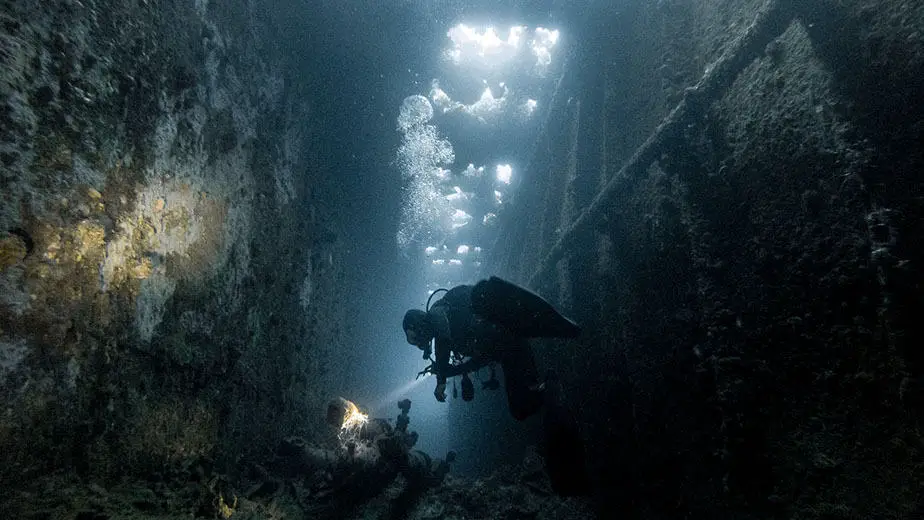
The deeper you dive, the faster your air will be used up. No, it has nothing to do with your breathing rate. It has everything to do with the pressure at depth.
As we mentioned in the Air Consumption Rate section, dive depth greatly affects your air consumption, which also means that it can limit how long you spend underwater. To know the extent it affects it, we need to first talk about some (simplified) diving physics.
The basic concept is this: the deeper we dive, the greater the pressure we are exposed to. This pressure causes the air in our scuba tanks to decrease in volume and become denser.
Using atmospheric pressure as our reference point (1 atmosphere of pressure at sea level or 0 m), we know that every 10 m underwater increases the pressure by 1 atmosphere. Thus, at a depth of 20 m, there is 3 atmospheres of pressure acting on you. Look at the table below for more details.
| Depth | Pressure | Volume | Density |
| 20 m | 3 bar | 1 /3 | 3x |
As you can see, due to the pressure, the air particles are at ⅓ their usual volume, meaning they are three times closer together (three times denser). To occupy the same lung capacity as usual, 3x the amount of air is required. Thus, at a depth of 20 m, the air in the tank is being used up at 3x the rate.
You can see how quickly the air volume decreases. At a depth of 30 m, the air volume is ¼ of what it normally is, and so it will be used up 4x faster.
Water temperature
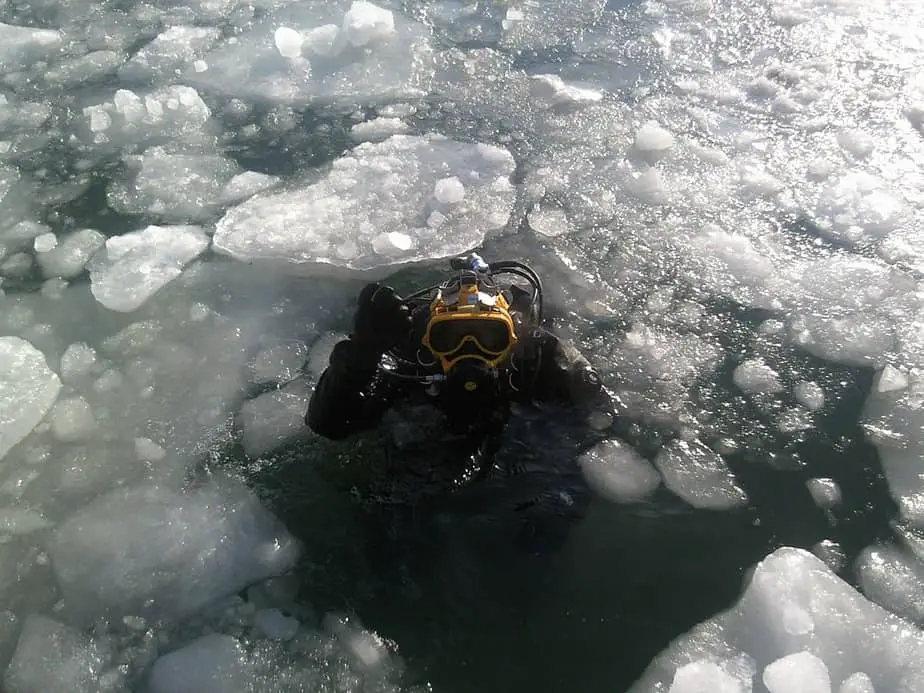
Generally, water temperature should not affect how long your dives are if you are wearing an appropriate exposure suit.
Sometimes people make the mistake of using their saltwater diving wetsuit for freshwater diving. They don’t realize the freshwater tends to be a lot colder, and that they need a 5 mm wetsuit or thicker. In this case, they are surfacing because their wetsuit is not insulating their heat well enough.
Hypothermia is a serious risk for divers. You do not need to be ice diving to be at risk of it. If you begin to feel cold, it’s a good idea to end your dive even if you still have plenty of air left in your tank.
If you plan on cold water diving, it’s possible to still wear a very thick wetsuit, but the smart option would be to use a drysuit instead.
Most divers who dive in cold waters will plan for a shorter dive instead of bringing in more scuba tanks to lengthen it. You can save your longer dives for your trip to the tropics instead.
Planned maximum dive time
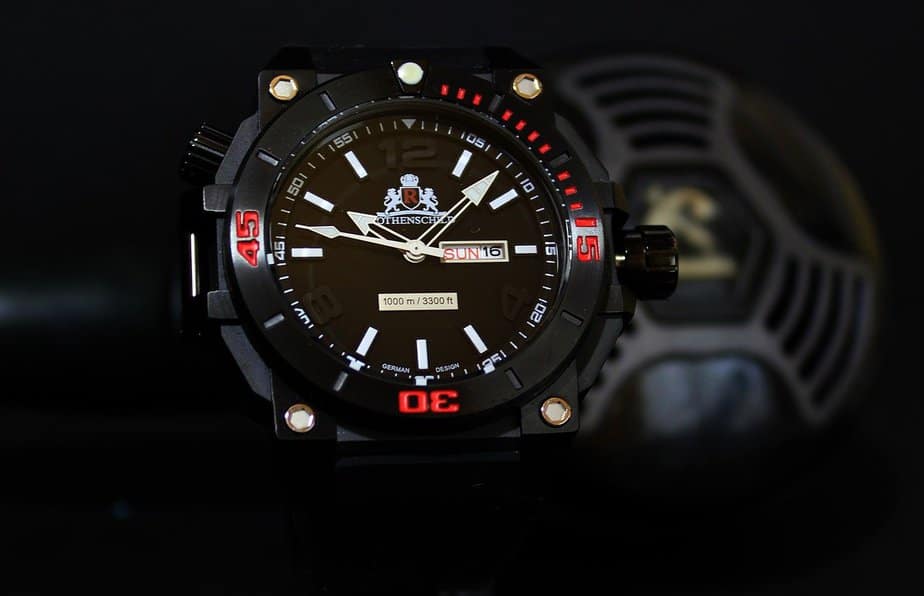
You should have a planned maximum dive time whether you are solo diving or diving on an organized trip.
There are many reasons to impose time limits. One reason could be that the boat needs to move to the next area or return to the dock by a specific time. Another reason could be that the chef needs to plan when to have lunch ready.
Realistically, one of the main reasons why there is an agreed upon maximum dive time is so that the surface cover can be aware when something might have gone wrong and send for help.
As you’ll have noticed by now, there are many reasons why one might need to start their ascent even if they have air left in their tank. This is yet another reason why you might be ascending early; adhering to a maximum dive time is a safety precaution that must be done regardless of how much air is remaining or fun you’re having.
Experience
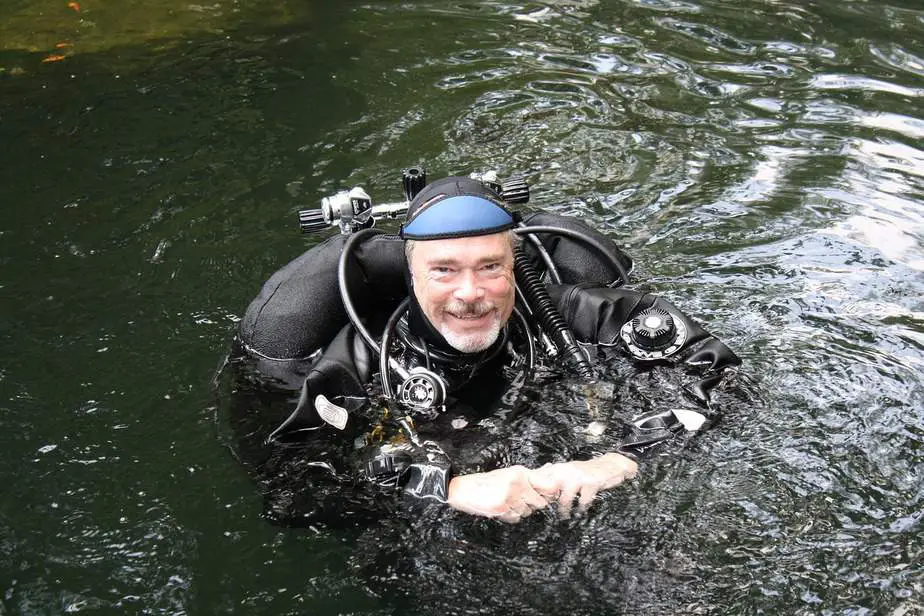
A diver’s experience can play a role in how long (or short) they can stay underwater. This is hard to quantify because there may be small efficiencies that experienced divers do that inexperienced divers don’t do that can result in a major difference in bottom times.
For instance, an experienced diver may be able to use their air more slowly than a newbie by having superior buoyancy control and calmer breathing.
A veteran diver will know when to put in effort and when to just go with the flow. For instance, they know how to not resist a current if they are caught in one, or how to swim out of one efficiently. After all, that’s literally what drift diving is.
They may know how to frog kick better, how to dive with a different breathing gas other than standard air such as nitrox or trimix, or any number of reasons.
If you happen to be a newbie, don’t try to keep up with someone more advanced. Focus on yourself, follow your own dive plan, and slowly accumulate experience. One day you will be the pro that can dive the longest that everyone looks up to.
Comfort
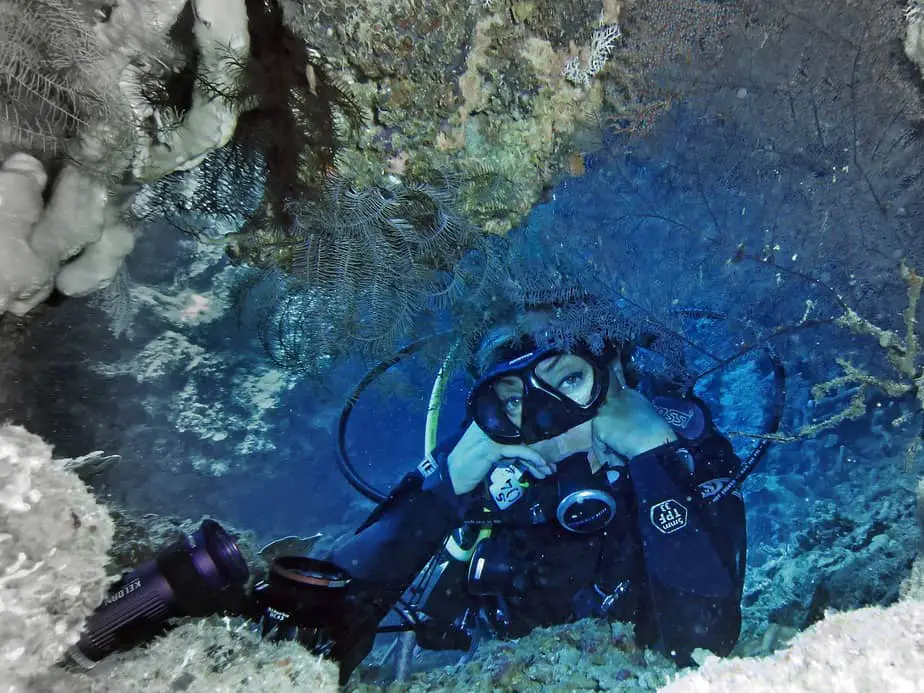
How comfortable you’re feeling underwater has an impact on how long you can stay underwater. Obviously, things like physical discomfort such as an uncomfortable mouthpiece, mask, fin, or any other piece of equipment will cause you to want to surface faster.
However, what we are referring to specifically is how you’re feeling inside. Yes, things like anxiety or excitement can shorten your dive by drastically increasing your heart rate.
For instance, you may be diving deeper than you ever have before, and this causes your heart rate to go up due to nervousness or excitement. Or you are diving with sharks, and you find that your air is running out much faster.
Being comfortable also has a psychological effect of making time seem to pass by faster. So even if you were diving for around the same amount of time as before, it might feel like barely any time has passed at all before you’re already surfacing.
On the other hand, if you’re feeling uncomfortable or are not enjoying the dive for any reason, you can end it at any time. Just make sure to let your dive buddy know, otherwise they’ll think you went missing.
How long do scuba dives last on average?

For most recreational dives under 18 m (60 ft), using an 80 cu ft. (3000 PSI / 207 bar) aluminum tank, we can assume the average dive is approximately in the range of 45-60 minutes.
It can be on the lower end if you had to exert yourself during the dive or didn’t control your breathing that well. It can be closer to the one hour mark if you were extremely efficient with your breathing and movements.
After this time, most divers would have reached the 3000 PSI / 50 bar safety stop gas limit. This means that it’s time to make your ascent. Since most dives are no-decompression dives, the only stop required is a 1-3 minute safety stop at a depth of around 3-5 m from the surface.
Technically, this means that the total time spent underwater can exceed an hour if you factor in how long it takes to ascend.
You can extend your dive by diving nitrox or using a twin tank setup. However, most divers get out after an hour because they are hungry, thirsty, cold, or need to use the bathroom and don’t want to go in their wetsuit.
Once you learn about technical diving, specifically diving CCR, you can greatly extend your bottom times. These divers can spend so long underwater that they need to eat and drink during the dive at some point to replenish their energy.
What are some ways to extend your bottom time?
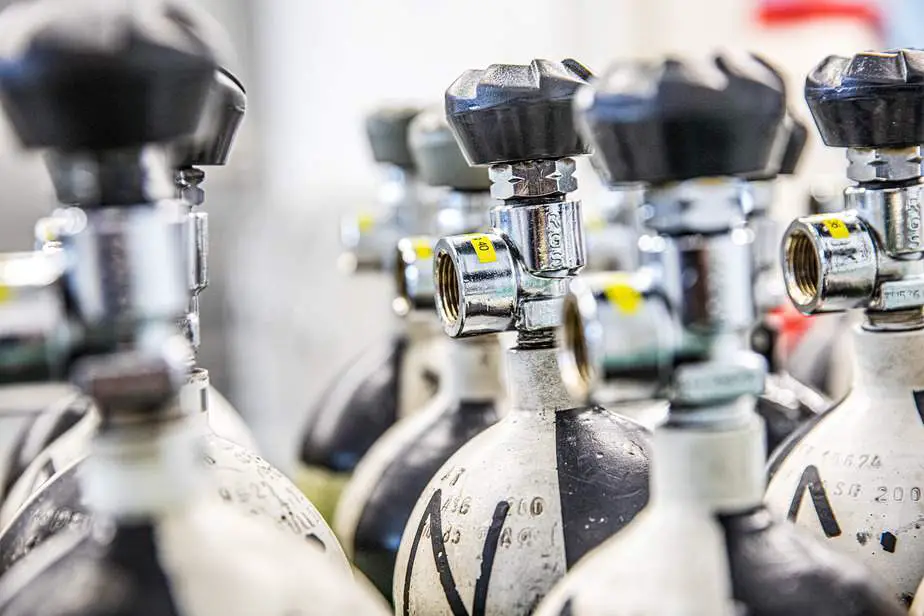
Other than learning a whole new style of advanced diving, what are some other ways that a recreational diver can spend more time underwater?
We have seen how there are many factors that can limit your dive length. If the goal was simply to spend a long time underwater, air supply and depth would be the greatest factors.
As we mentioned in the No-Decompression Limits section, at a depth of 10 m or less, divers can theoretically spend over three hours there without doing a decompression stop.
So what if you were to spend all of your time at under 10 m and brought three scuba tanks instead of one? You could literally dive for hours. You could also dive nitrox which would increase your NDL even further.
At this point, the limiting factor isn’t even the air supply anymore, but rather practical factors like dealing with the cold, hunger, and thirst. Essentially, the same issues that technical divers face but at much shallower depths.
Technical divers that spend hours underwater at deep depths have to worry about things like nitrogen narcosis and oxygen toxicity and decompression stops. To deal with this, they have to use special breathing gases called trimix, which adds helium into the mix. These are complicated topics that you can learn about by taking the appropriate technical diving courses.
Do twin tanks double your dive time?
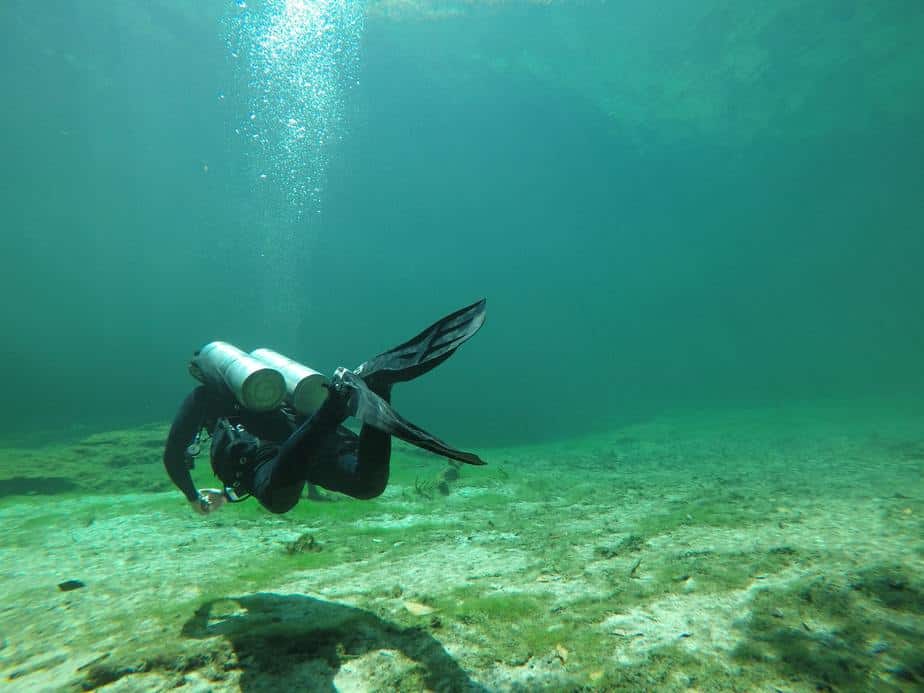
You may have seen people diving with twin tanks and wondered if they can literally dive for twice as long. The answer is yes.
There are a couple of reasons for this. Assuming that each tank is 3,000 PSI, then this diver effectively has 6,000 PSI worth of compressed air to breathe during their dive. This means more time underwater, obviously.
However, there is a functional benefit to this design. These twin tanks have separate regulators, however they are also connected.
Let’s say two divers both go for two afternoon dives. One diver is using a twin tank setup. The other uses one tank for the first dive, goes back to the boat and switches tanks for the second dive. Who can dive for longer?
Technically, the twin tank diver is more efficient with his air usage. The other diver has to discard the air remaining in his first tank when he switches tanks. The twin tank diver can keep on using his twin tank and completely use up the air in one of the tanks without waste before using the air in the other tank.
Thus, there is less wastage of air in a twin tank setup which means that air can be used for a longer dive. Twin tanks are an effective solution for someone who uses air more aggressively than the average diver and is also great as a safety feature.
Why should I stay underwater for longer?
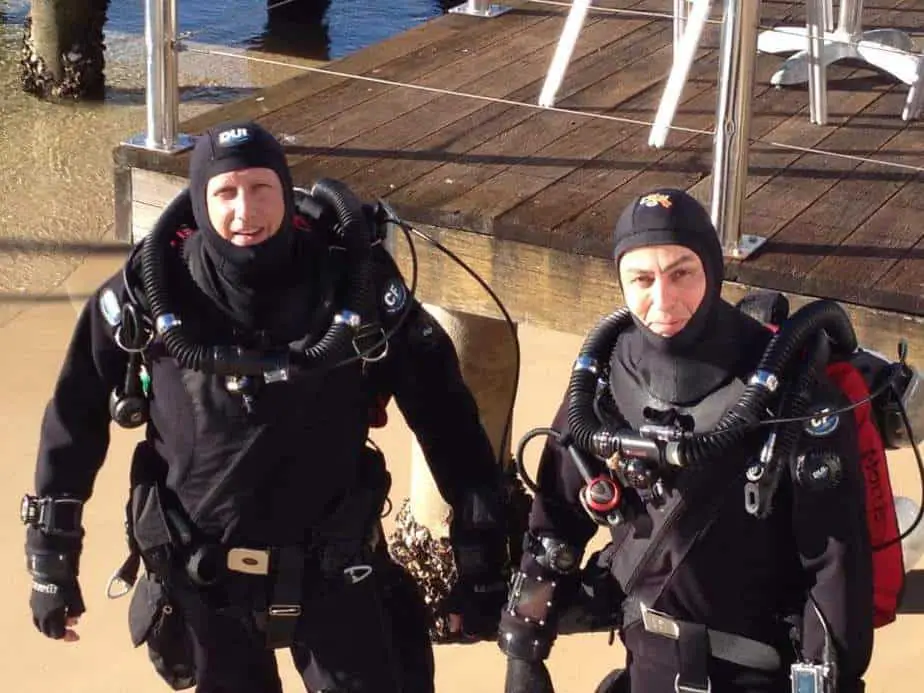
Is staying underwater the longest an ego thing? Are there actual benefits for staying underwater for longer?
This all depends on how much you enjoy scuba diving. There are some people who love their time underwater. They love to explore and find new species of fish. For these people, the longer they spend underwater, the more they can explore and see something exciting.
Also, when you’re good at something, it’s simply a joy to do it. Divers who get into the groove and are managing their buoyancy, swimming efficiently, and covering more ground than they ever have before find it immensely satisfying. They don’t want the experience to end.
Furthermore, scuba diving is also great exercise. On a longer dive, you will probably burn more calories. Then you can enjoy your vacation knowing that you aren’t going to gain any weight, and in fact, maybe you’ll even drop a few pounds while eating to your heart’s content.
What are the downsides to longer dives?
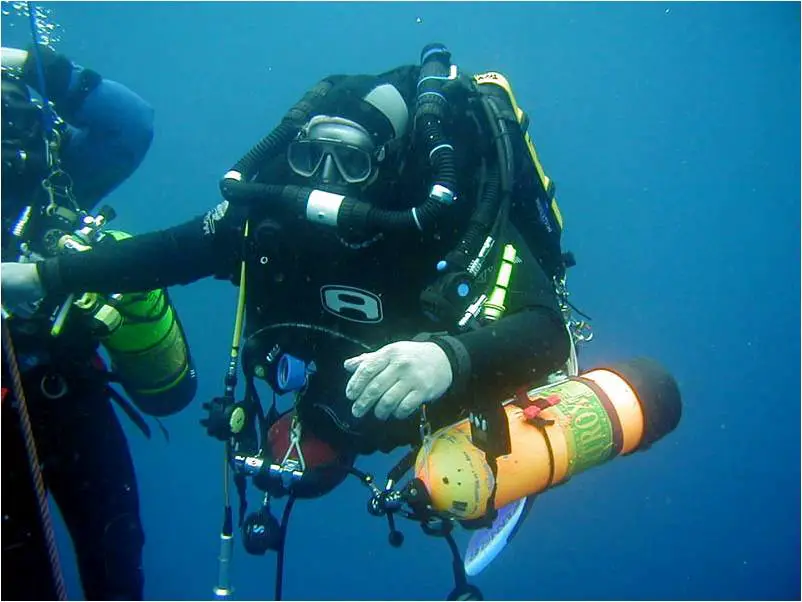
In addition to the potential discomfort you face regarding the cold, hunger, or thirst, you will need to consider the additional cost. First, you’ll need a bigger tank, or multiple tanks.
If you want to learn technical diving, particularly CCR diving, that is also a major expense that requires significant training and all new equipment. Even the gas mixes you’ll be using will be different and significantly more expensive than standard air.
The biggest disadvantage to long dives is the cold. Our body temperature is going to be naturally warmer than the water we’ll be diving in, even if the water is considered “warm.” The entire time you’re diving, your body temperature will be slowly but steadily decreasing.
Even with a thick wetsuit or drysuit on, you’ll eventually get cold. It’s not a matter of “if”, but “when.” Plus, you’ll also need to eat and drink at some point.
Dehydration is a major issue because it can make you more susceptible to decompression sickness. You’ll also naturally sweat, urinate, and lose all kinds of fluids through diving that needs to be replenished. So if you plan on diving for longer than an hour, consider how you’ll be eating and drinking.
Furthermore, diving for a long time might actually run the risk of getting boring. Unfortunately, it is possible to have too much of a good thing. You could eat a chocolate bar as a guilty pleasure, but if you were forced to eat it for every meal you probably wouldn’t even last the day. The same is true of diving – just how long do you need to dive before you get bored of a dive spot?
We don’t recommend doing long dives every dive, otherwise you might get sick of scuba diving really quickly.
How do I calculate how long I can stay underwater?
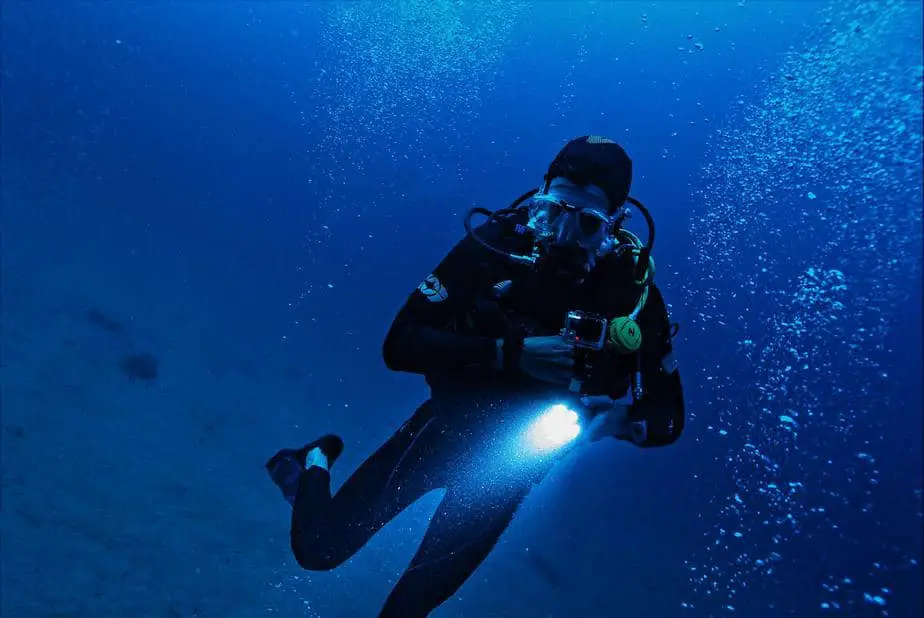
What you’re really asking is how to calculate your no decompression limit for a dive. For that, you’ll need a dive table or a dive computer.
You’ll learn how to use dive tables during your Open Water Diver course. Dive tables were how old school divers planned their dives. Nowadays, they may be somewhat obsolete with the availability of dive computers.
There is a bit of a debate on whether one should put so much faith in a dive computer’s algorithms. The major advantage of a dive computer is that it can perform calculations in real time, as you are diving. A dive table is static and doesn’t take into account the ever changing flow of a dive.
Thus, we advocate for a hybrid approach. You should have a general idea of what your NDL is by calculating it manually. But when you’re diving, you can just use your dive computer. If the calculations seem wildly off and you suspect your dive computer is malfunctioning, then you can begin your ascent.
By already having a ballpark estimate of your NDL, you can tell when something is clearly off with a dive computer’s calculations. You should also be referring to your pressure gauge for how much air you have left.
Despite all of your planning, things don’t always go according to plan. You need to make a judgment call regarding if you can continue as planned or if you should call it and begin your ascent. Factors such as the temperature, your comfort level, unexpected setbacks, etc, can be reasons you end a dive earlier.
Parting words
Generally, the average recreational diver will find that a standard 80 cu ft. 3000 PSI aluminum tank will last for 45-60 minutes at depths of around 40 ft. This number is variable based on fitness level, breathing rate, exertion, and dive depth.
Divers who want to spend a longer time at deep depths need to learn about technical diving, specifically diving with a closed-circuit rebreather and trimix diving.
If you currently find that your bottom times are much lower than other divers, then you probably need to work on your breathing rate, fitness level, and possibly getting a larger tank or using a twin tank setup.

